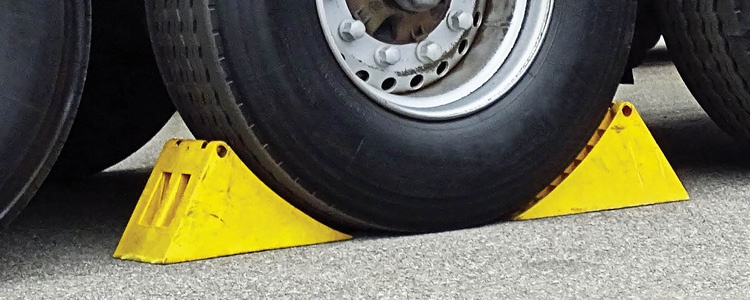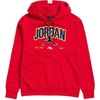Have you ever taken a moment to ponder those unassuming blocks tucked behind the wheels of an airplane on the tarmac or a colossal cargo ship resting in a harbour? They might appear inconspicuous, but those are wheel chocks, and they're on the front lines of safety for various modes of transportation.
In this article, join me on a captivating journey through time as we explore the evolution of wheel chocks. We'll trace their origins from humble wooden blocks to the innovative materials that make up modern chocks.
The Early Days: Wooden Wheel Chocks
Wheel chocks have been part of our transportation history for centuries. Picture this: simple wooden blocks or logs thoughtfully placed in front of and behind the wheels of horse-drawn carriages, preventing them from rolling away. These basic wooden chocks served their purpose remarkably well.
As I ventured further into their history, I uncovered that the Industrial Revolution brought significant changes to transportation. With these transformations came the demand for improved wheel chocks. During this era, wheel chocks continued to be fashioned from wood, often taking on a wedge shape to securely lock the wheels in place.
The Shift to Rubber and Metal
Fast-forward to the 20th century, where the landscape of transportation was evolving rapidly. While the dependable wooden wheel chock had served generations faithfully, it was time for a modernization. Heavier and faster vehicles were on the scene, and engineers and inventors began exploring alternative materials.
One of the most exciting innovations was the introduction of rubber. Rubber chocks offered a remarkable grip, durability, and resistance to adverse weather conditions, outperforming their wooden counterparts. Moreover, they were more manageable due to their lightweight nature.
With the rise of aviation in the early 20th century, wheel chocks had to adapt to the specific requirements of aircraft. This led to the creation of metal chocks with intricate designs, providing increased stability for planes on runways and aprons. Handles and ropes were added for convenience in handling and placement.
Modern Wheel Chocks: The Technological Revolution
As my journey into the evolution of wheel chocks continued, I was astounded by how they had kept pace with technological advancements. Today, there's an extensive variety of wheel chocks constructed from high-strength plastics, composite materials, and even aircraft-grade aluminium. SafetyFirst noted that these modern materials offer numerous advantages, including reduced weight, enhanced durability, and resistance to corrosion.
The story doesn't end there, though. Modern wheel chocks boast impressive features. Some are equipped with built-in reflectors for safety in low-light conditions, ergonomic handles, and non-slip surfaces for user-friendliness.
Furthermore, the aviation industry has crafted specialized wheel chocks designed to withstand extreme conditions, including the colossal forces generated by jet engines during aircraft engine testing.
Conclusion
The evolution of wheel chocks is not merely a historical account but a journey through human innovation and the ever-changing demands of transportation. From humble wooden blocks to cutting-edge composite materials, wheel chocks have traversed a remarkable path. They continue to adapt, ensuring the safety and stability of vehicles and aircraft.
As technology advances further, we can anticipate even more thrilling innovations in wheel chock design and materials. Whether you find yourself on a bustling airport tarmac, a sprawling cargo ship's deck, or in the pit stop of a Formula 1 race, wheel chocks will always play a pivotal role in ensuring our safety in a dynamic world. Keep in mind that those seemingly ordinary blocks represent centuries of evolution in engineering and materials science, working harmoniously to keep us grounded and secure.
FAQs about Wheel Chocks and Their Evolution
Q1: What is the primary purpose of wheel chocks?
A1: Wheel chocks are designed to prevent vehicles and aircraft from unintentionally moving. They serve as a safety measure to ensure stability and minimize the risk of accidents.
Q2: How did wheel chocks evolve from wooden blocks to modern materials?
A2: Wheel chocks started as simple wooden blocks used under horse-drawn carriages. Over time, with the advent of the Industrial Revolution, they continued to be crafted from wood but took on wedge shapes for better stability. In the 20th century, rubber and metal became popular materials for chocks due to their enhanced grip and durability. Today, advanced materials like plastics, composites, and aluminum are used for their strength and resistance to corrosion.
Q3: What advantages do modern materials offer in wheel chock construction?
A3: Modern materials such as high-strength plastics, composites, and aircraft-grade aluminum provide several advantages. They are lighter, more durable, and resistant to corrosion compared to traditional materials like wood. Additionally, they can be molded to include advanced features like ergonomic handles, non-slip surfaces, and built-in reflectors.
Q4: Are wheel chocks used exclusively in aviation and shipping industries?
A4: While wheel chocks are commonly associated with aviation and maritime applications, they are also used in other industries. For example, they are essential in construction, mining, and agriculture to secure heavy machinery and vehicles.
Q5: Are there specialized wheel chocks for unique applications, like aircraft engine testing?
A5: Yes, there are specialized wheel chocks designed to withstand extreme conditions. These chocks are engineered to handle the tremendous forces generated by jet engines during aircraft engine testing. They are crucial for maintaining safety during these high-intensity operations.
Q6: Can I use any type of wheel chock for my vehicle or equipment?
A6: It's important to choose wheel chocks that are appropriate for the specific size and weight of your vehicle or equipment. Using the wrong type of chock can compromise safety. Refer to the manufacturer's guidelines or consult with a professional to determine the right wheel chocks for your needs.
Q7: Are there regulations or standards governing the use of wheel chocks?
A7: Yes, various industry standards and regulations exist to ensure the proper use of wheel chocks. These standards vary by industry and application. It's essential to adhere to these guidelines to maintain safety and compliance.
Q8: Can I purchase wheel chocks for personal use, such as securing a trailer or RV?
A8: Absolutely. Wheel chocks are readily available for personal use and can be found in automotive supply stores or online retailers. When selecting wheel chocks for personal use, consider the size and weight of your vehicle or trailer to ensure they are suitable for your needs.
Q9: Do wheel chocks require maintenance?
A9: Wheel chocks, especially those made of modern materials, typically require minimal maintenance. Inspect them regularly for signs of wear or damage and clean them as needed. Proper storage, away from extreme temperatures and direct sunlight, can extend their lifespan.
Q10: Are there safety tips for using wheel chocks effectively?
A10: Yes, here are some safety tips:
- Always use wheel chocks on a level surface.
- Place chocks snugly against the tire and in contact with the ground.
- Use chocks in pairs, one in front of and one behind each wheel.
- Make sure chocks are appropriate for the size and weight of the vehicle or equipment.
- Remove wheel chocks before attempting to move the vehicle or equipment.
Remember that the effective use of wheel chocks is essential for safety, whether in industrial settings or for personal use.


No comments yet